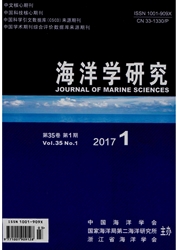

 中文摘要:
中文摘要:
利用2006—2007年"908-ST04区块"任务单元在长江口开展的春、夏、秋、冬四季多学科综合调查资料,分析了长江口水体溶解氧的季节变化,探讨了其底层低氧的形成机制,结果表明:冬季,表层和底层水体溶解氧值总体上呈近岸高、外陆架低的分布趋势,水体上下混合均匀;春季,藻华开始出现,水体层化初成,外陆架入侵的低溶解氧浓度水团和上层沉降的生物碎屑,使水体的低氧状况开始发展;夏季,在长江口锋面北侧底层水体中呈现1个"低氧带",溶解氧最小浓度为2 mg/L;秋季,在122.5°E以东的陆架区,可观测到呈块状分布的溶解氧低值区和夏季缺氧核心区的残留。由于受人文活动和自然变化的双重影响,长江口水动力因素和生态响应复杂多变。长江冲淡水的扩散为该区域水体的缺氧提供了营养盐支持,台湾暖流水入侵和上升流为缺氧水体提供了较小的溶解氧背景值,而强烈的水体层化阻止了底层氧和上层高氧带的垂直交换。颗粒有机碳和总溶解有机碳的分布趋势表明,陆源有机质对低氧的贡献可能是有限的。
 英文摘要:
英文摘要:
Seasonal variations of Dissolved Oxygen(DO) concentration in the water samples from Changjiang River Estuary and adjacent area were analyzed,which were obtained during 2006 and 2007 cruises.In winter,DO concentration was higher in the outer shelf than that in the coast area and homogeneous in the water column.In spring,water column stratification,algae bloom and the settling organic matter consumed the preformed low oxygen provided necessary conditions for the development of bottom water hypoxia.In summer,there was a "low oxygen zone" in the northern of the front with the minimum value was 2.0 mg/L.In autumn,low concentration patches were observed in the east area of 122.5°E,these maybe the residue of summer hypoxia.Because of the mixed influence of anthropogenic activity and natural variation,the biogeochemistry dynamics and ecology response were complicated.Changjiang plume provided inorganic nutrients for phytoplankton growing,Taiwan Warm Current intrusion offered a low preformed oxygen value,water column stratification prohibited gas exchange between bottom and upper water.On the other hand,the distribution patterns of Particulate Organic Carbon(POC) and Total Organic Carbon(TOC) illustrated that terrigenous organic matter maybe no significant contribution to the formation and development of bottom water hypoxia.
 同期刊论文项目
同期刊论文项目
 同项目期刊论文
同项目期刊论文
 期刊信息
期刊信息
